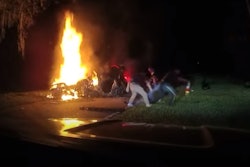 Photo: Mark W. Clark/POLICE File
Photo: Mark W. Clark/POLICE File
Police vehicle pursuits are inherently hazardous. Every police officer is trained in safe operation of a motor vehicle—squad car, motorcycle, four-wheel-drive pick-up, and the like—at high speed, but nearly all of the offenders they're chasing are careless, reckless novices with little regard for safety. Countless chases end in crashes, with all manner of mayhem involving property damage and personal injury to violators and innocent victims alike.
Police vehicle pursuits can at times also be deadly. So far this year, two law enforcement officers have been killed in vehicle pursuits. Three officers died in this manner last year and two in the year before that. In the previous decade (2010-19) a total of 41 officers died in vehicle pursuits.
Civilians lives are also at risk. According to a study conducted by the Society for Advancement of Violence and Injury Research (SAVIR) and published in Injury Prevention, there were 2,654 fatal crashes involving 3,965 vehicles and 3,146 fatalities in the nine-year period from 1994-2002. Of these, 1,088 were people not in the fleeing vehicle
The study found that "crashes often occurred at high speed, in the night, on local roads" and that "most of the pursued drivers had prior motor vehicle related convictions."
The study further concluded that "fleeing drivers were more likely to be male, were younger, less likely to be restrained, and much more likely to be intoxicated or test positive for drugs."
Law enforcement trainers, leaders, and manufacturers of police equipment are constantly seeking ways to decrease the dangers of police pursuits. To discuss this, POLICE Magazine convened a virtual roundtable discussion on the topic. Participants included:
- William Martin, public safety business manager, FAAC Incorporated
- Lieutenant (ret.) Michael Ledoux, director of business development for Carfax for Police
- Leonard Stock, founder and creator of the Grappler Police Bumper
What is the most important issue today in vehicle pursuit safety?
William Martin, FAAC: The degradation of motor skills: If you find yourself in a high-speed pursuit today, based on most pursuit policies, it would be very much like finding yourself in the middle of an active shooter situation—it doesn't happen often, but when it does it is the ultimate test of a controlled response to a crisis situation. Remember, the first things to dissipate under stress are motor skills.
Michael Ledoux, Carfax for Police: Public safety is the number one priority for vehicle pursuits. Barring a "No Pursuit Policy," being able to evaluate risks is imperative in making what are split-second decisions. Dispatch can share "intel" from multiple sources—whether it's traffic conditions and events happening in the region, or information on the vehicle and persons of interest involved—which help officers determine the best way to respond, making it safer for all involved. Indicators of suspicious activity on the vehicle, where the vehicle has been, or high mileage, provide data to back up, and inform those decisions.
Leonard Stock, Grappler Police Bumper: During a police pursuit, a fleeing suspect's top priority is to avoid being arrested. Of course, that means the suspect's regard for everyone else's safety is low on their priority list. Members of law enforcement engaged in a pursuit are constantly assessing the risk to the general public as well as other sworn officers. We are all at risk of injury or death by the reckless behavior of a fleeing suspect.
What can police agencies do to improve training to solve this problem?
William Martin, FAAC: Departments can improve preparation for these critical situations by not only providing more training, but more accurate training. The standard Emergency Vehicle Operation Course (EVOC) is not enough. The CaPOST study clearly showed that the best results for driver's training was the combination of EVOC and scenario-based driving simulations.
Just like we train in our MILO Force Options/De-escalation simulator (shooting simulator), we are able to train the same in the FAAC driving simulator (de-escalation driving)—provide officers situations and/or scenarios that they learn to make the right decisions (experience), which they revert to under stress. However, sadly we know that inconsistencies amongst driving instructors can often filter these critical principles of training delivery.
Michael Ledoux, Carfax for Police: Policy is tantamount in agency response, and it's a given that procedural training needs to align with current policy. Often community input drives pursuit policy decisions, however, public opinion fluctuates regarding those policies. Agencies have an opportunity to connect with their community in high-profile pursuit situations.
When a pursuit results in a safe outcome, agencies need to share the news of what went well proactively. We must do a better job of sharing our positive stories—it opens dialogue and benefits all of us, law enforcement and the community alike.
Leonard Stock, Grappler Police Bumper: [Declined to answer]
What are some solutions being developed by the manufacturers?
William Martin, FAAC: FAAC has developed and patented the Virtual Instructor Trainee Assessment and Learning System (VITALS). This unique system allows agencies to map their own policies into the assessment component of student performance in order to reduce instructor bias and filters based on their personal preferences. It provides departments with more consistent delivery of training and students with a highly accurate and more comprehensive performance feedback.
VITALS is beyond scoring as it not only assesses performance within or outside policy, but it captures performance that is "pushing the envelope" of department policies regarding student driving. Be ready for the "big one", reduce department liability and train to department standards not "field practice" or "locker room legend."
Michael Ledoux, Carfax for Police: There is much opportunity for manufacturers to innovate in hardware and software to support safer pursuit tactics, and training using real-world application of tools is imperative. But training on tools is a given if you're a manufacturer. What about serving the broader needs of law enforcement? Our Investigating Trends Series is an interoperable, collaborative resource, because crime is multijurisdictional. We host virtual trainings with expert panels every other month on topics like catalytic converter thefts, digital data usage for violent crime, missing persons trends—because, one, it's necessary, and two, why shouldn't we all benefit from each other's knowledge and experience?
Leonard Stock, Grappler Police Bumper: The Grappler device allows LE to seize a moving vehicle when the conditions are best suited for maximum public safety. The majority of field grapples are performed prior to lighting up a suspect in order to reduce risk. Whether it's a verified stolen vehicle or wanted fugitive, surprising the suspect by stopping the vehicle in a matter of seconds has proven to be effective.
Final Words
Letting criminals get away with criminal behavior is not a solution for reducing crime. Some criminals flee the police and must be apprehended. Some of those who flee do so in a motor vehicle. This fact doesn't make them less dangerous to public safety—it does quite the opposite.
Meanwhile, law enforcement leaders have come under increasing public pressure to reduce the incidents of police vehicle pursuits. Some have taken what they believe to be the high road and instituted highly restrictive policies involving complex risk-reward calculus of initiating and/or discontinuing a pursuit—some have taken the path of least resistance and barred vehicle pursuits altogether. Still others have looked to make increased investments in training and tools for their officers.
Ultimately, the answer to the question on making vehicle pursuits safer and more successful will likely be found—as most answers typically are found—somewhere in the middle ...of the road.
















